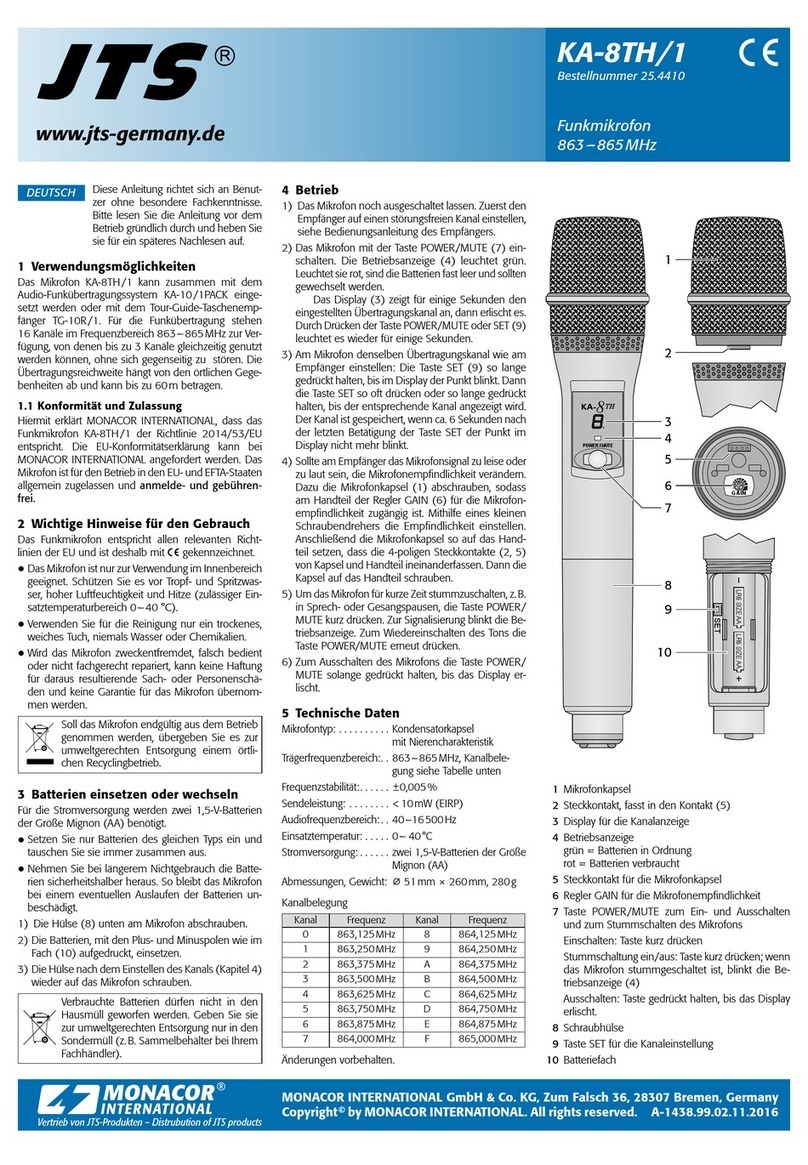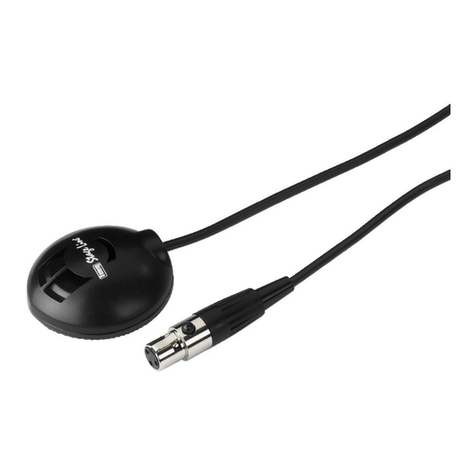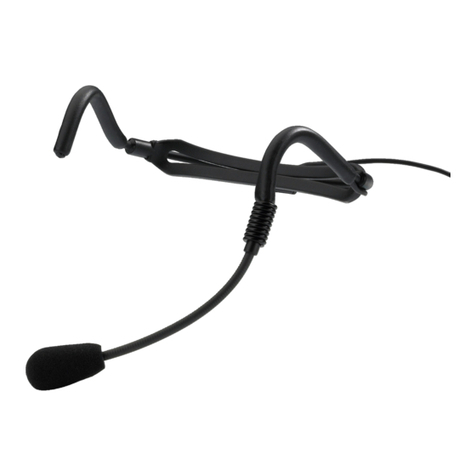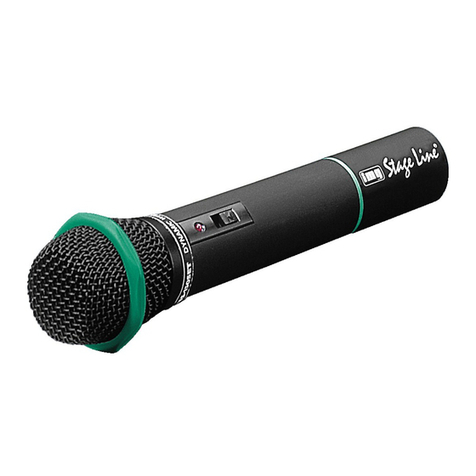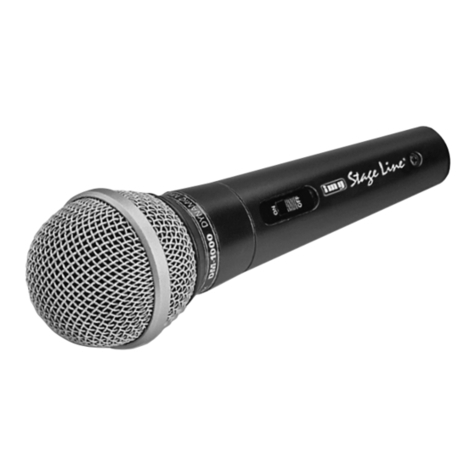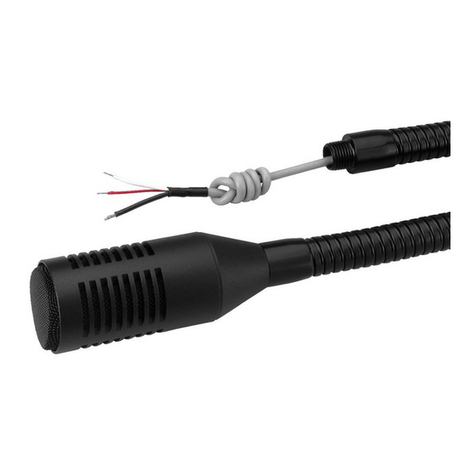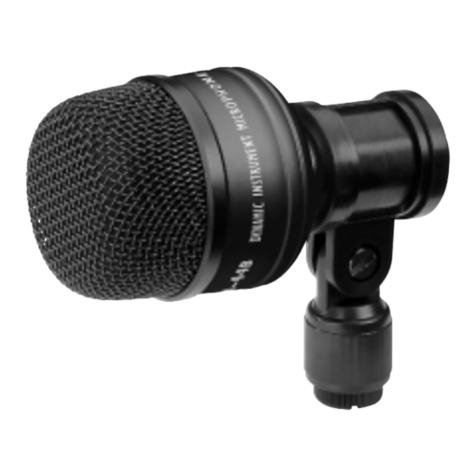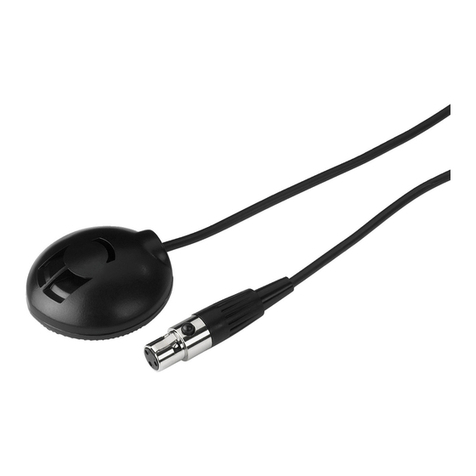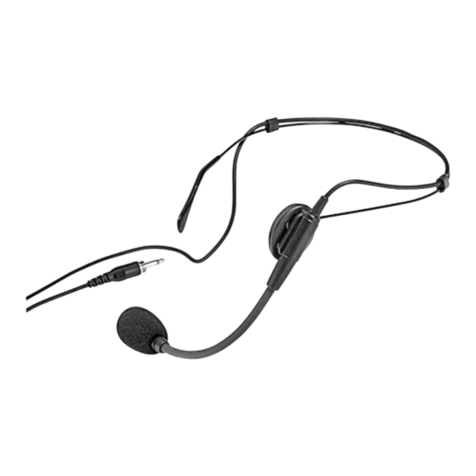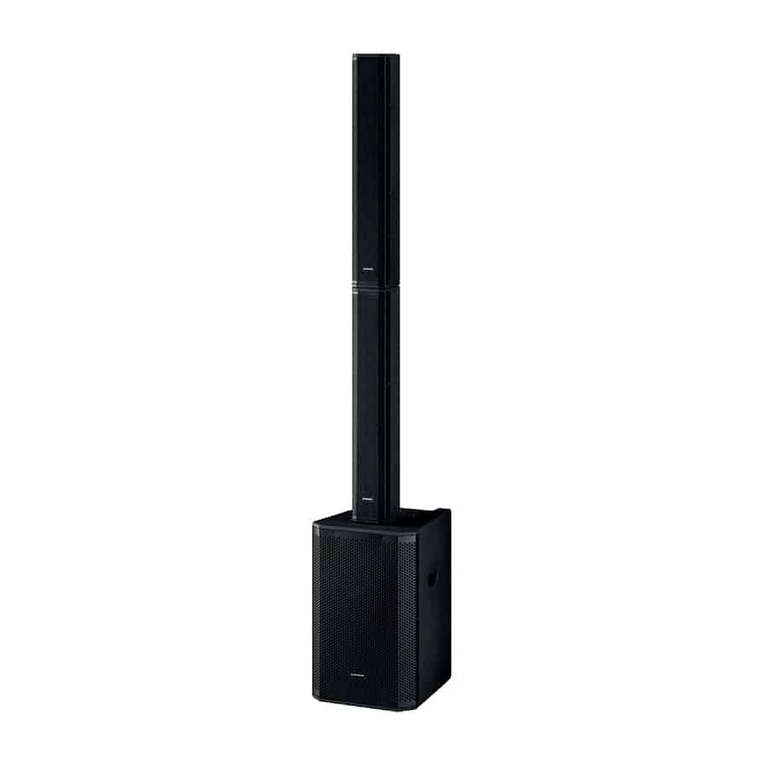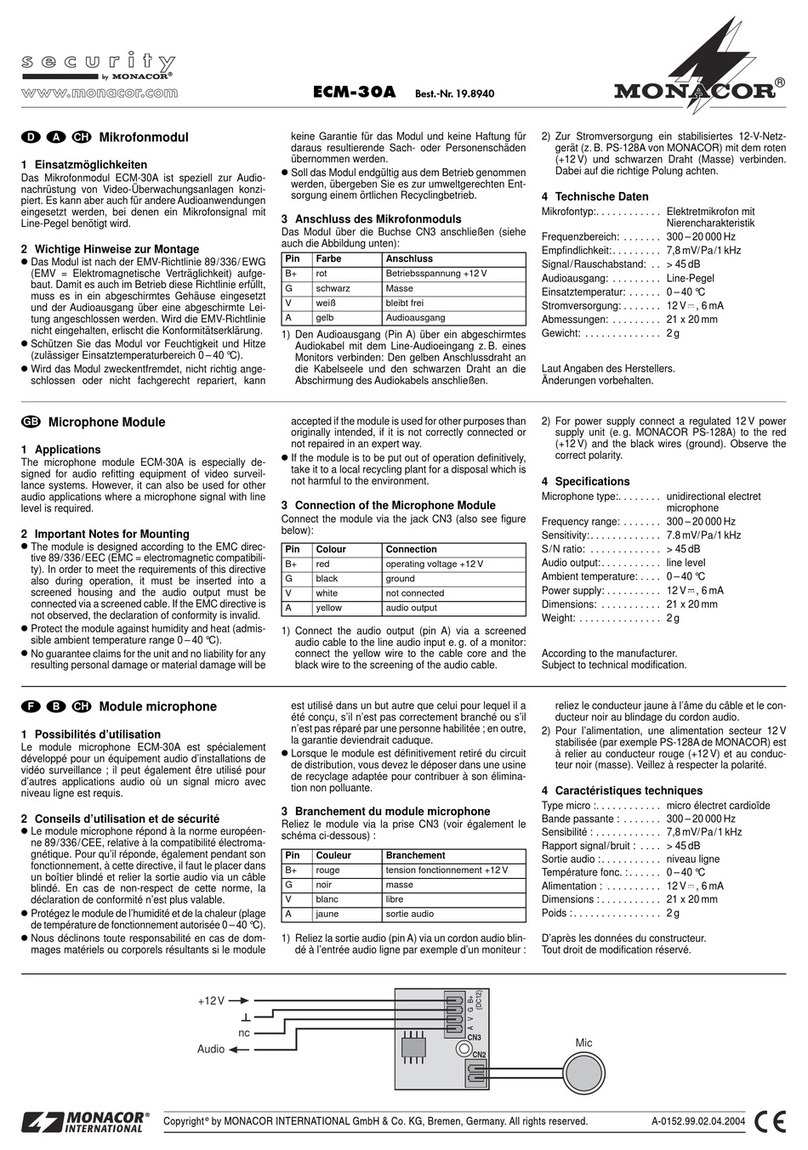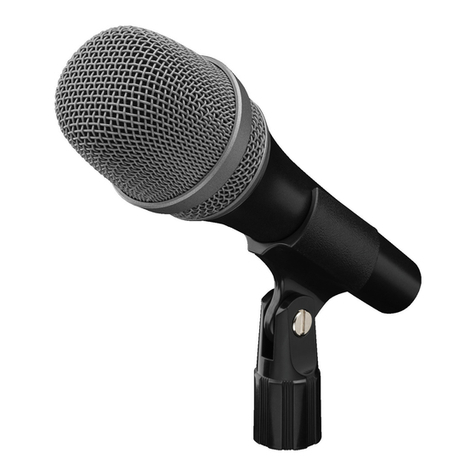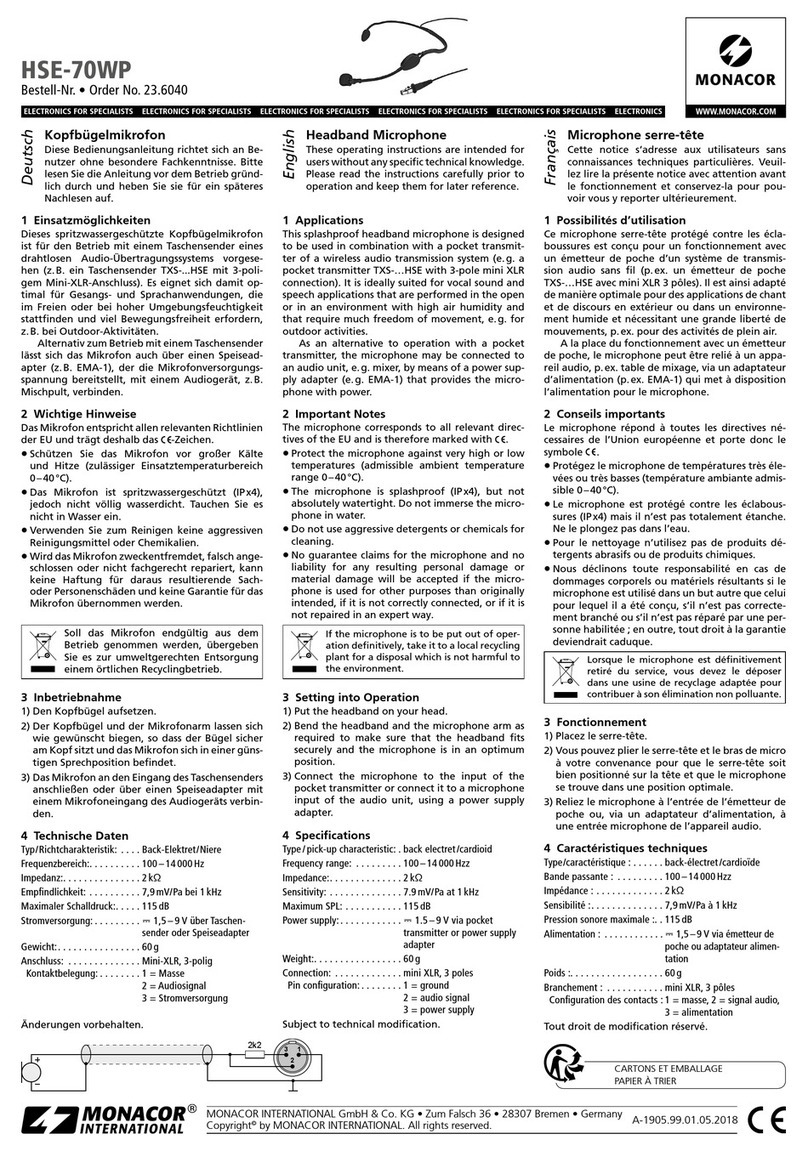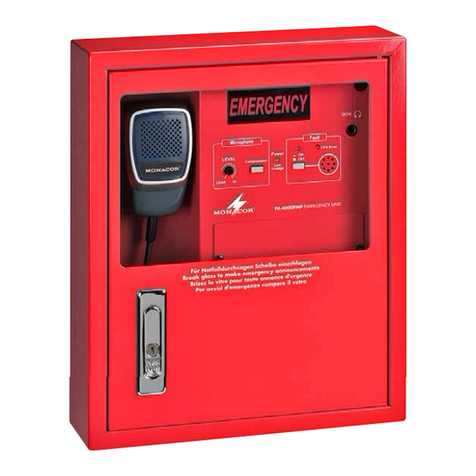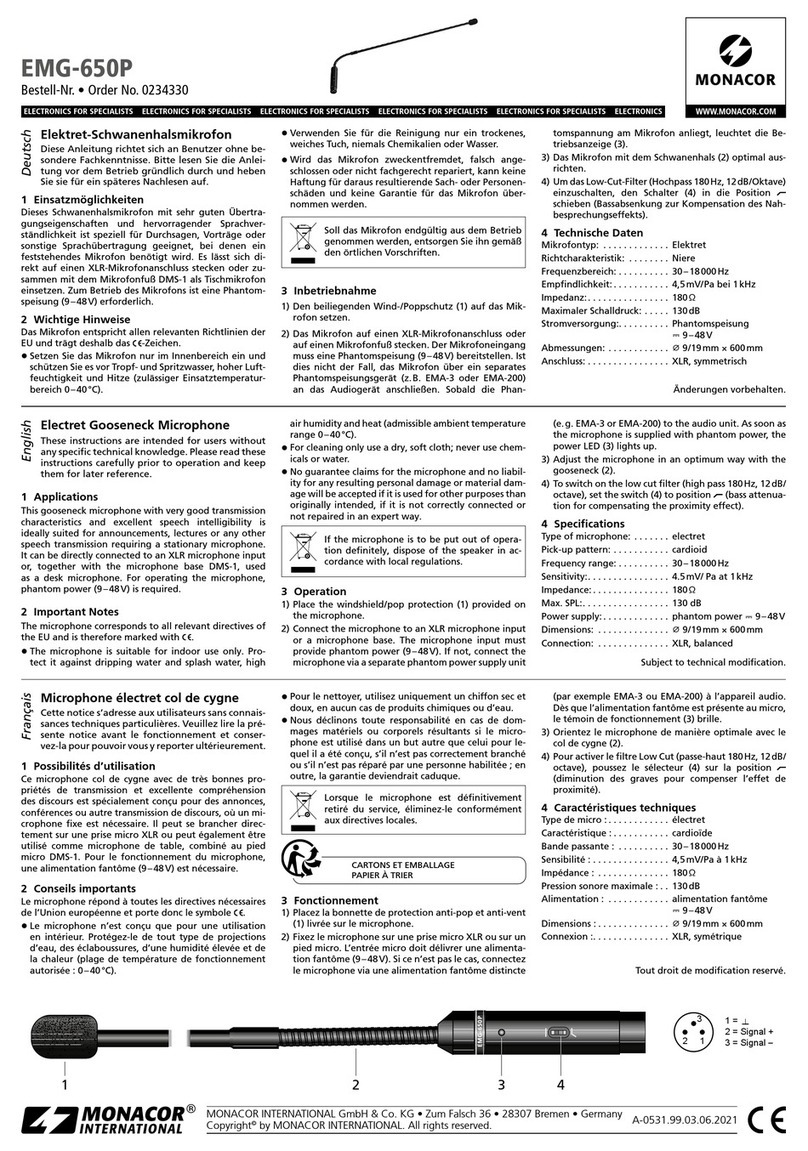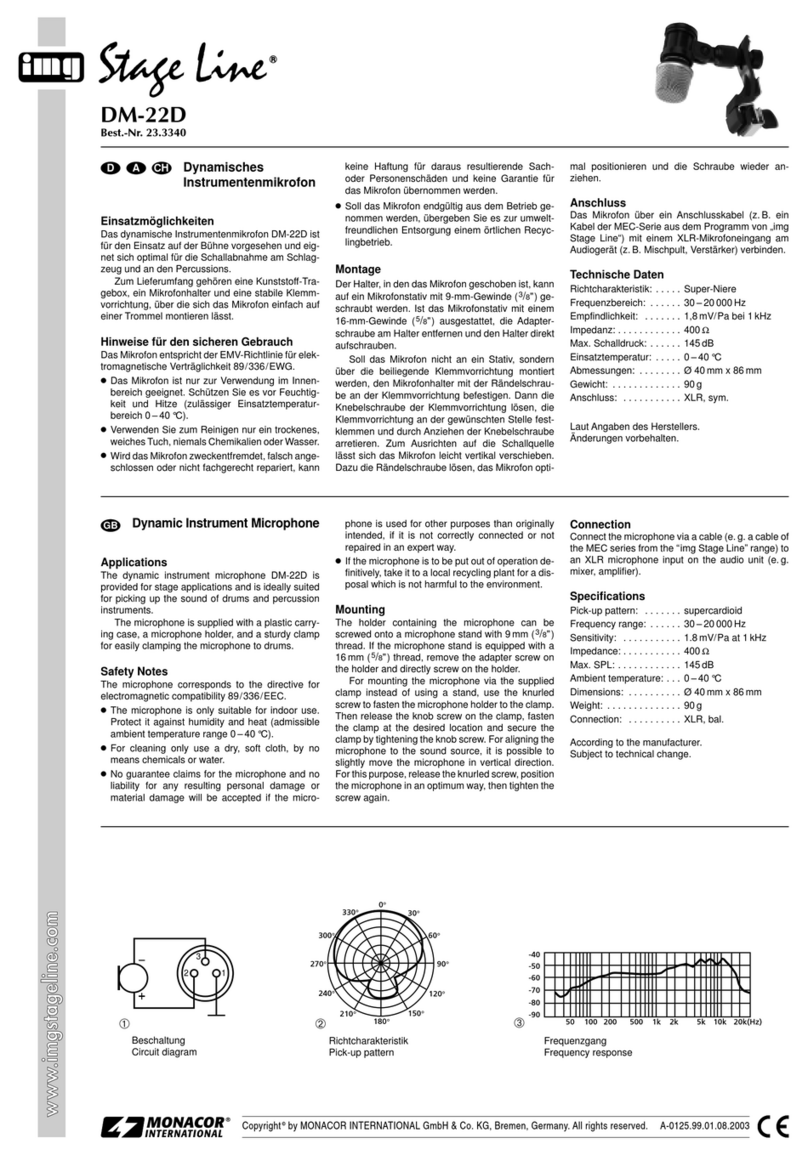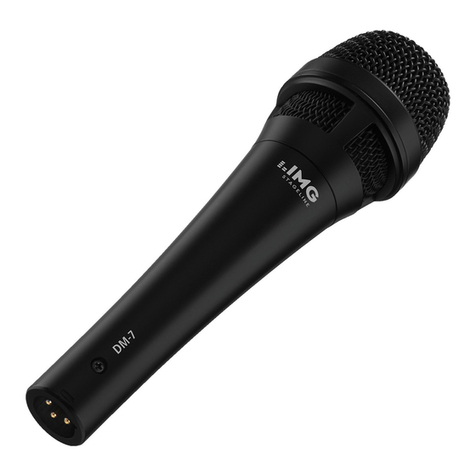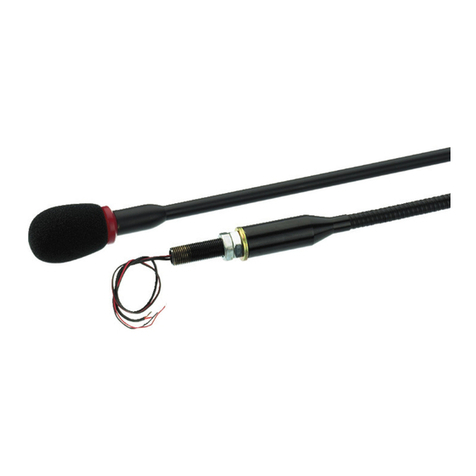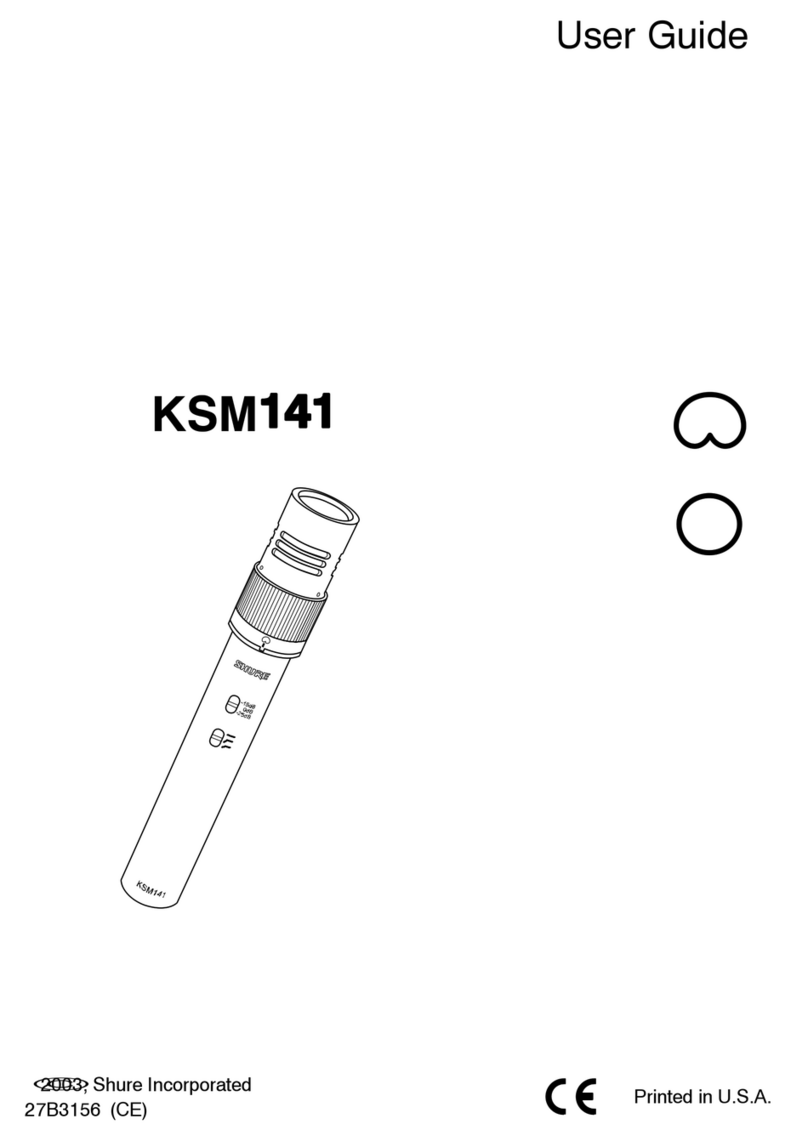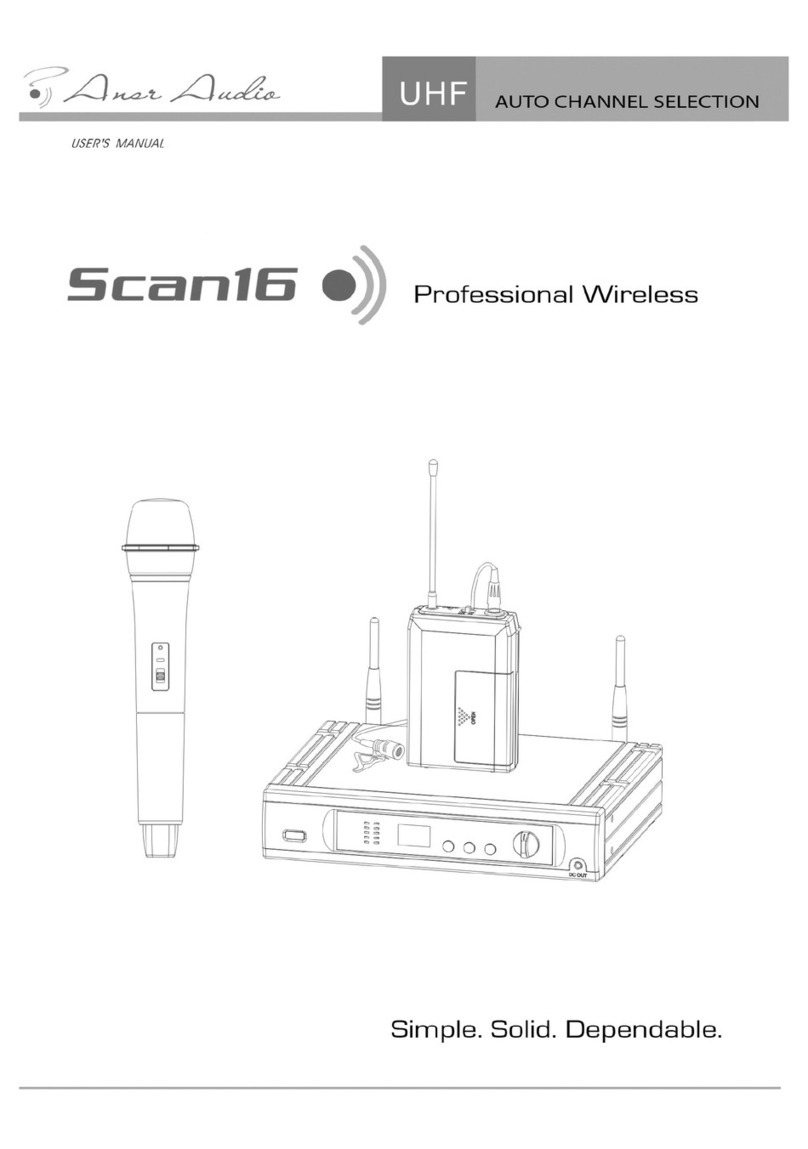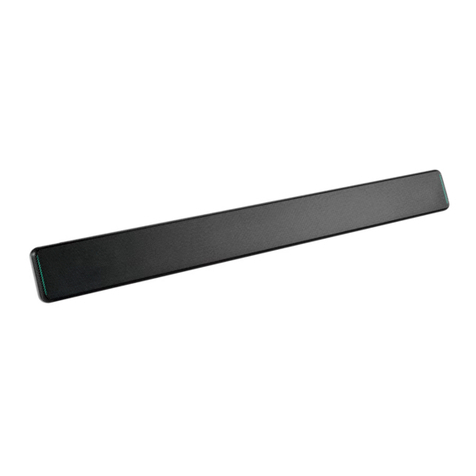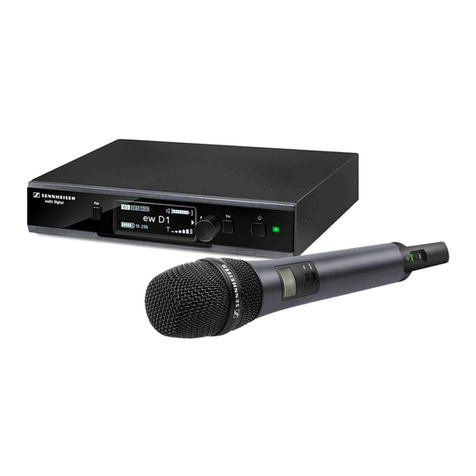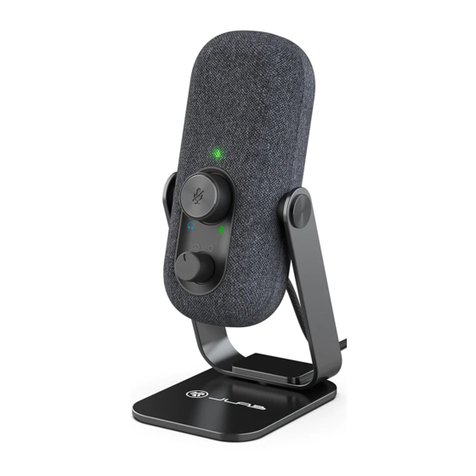Frequenzgang
Frequency response
Courbe de réponse
Elektret-Mikrofon-Set
Bitte lesen Sie die Bedienungsanleitung vor dem Betrieb gründ-
lich durch und heben Sie sie für ein späteres Nachlesen auf.
1 Einsatzmöglichkeiten
Die zwei Overhead-Mikrofone des Sets ECM-250 eig-
nen sich optimal für die Schallabnahme am Schlag-
zeug (z. B. für Becken) und an Perkussionsinstrumen-
ten. Sie werden mit 48-V-Phantomspeisung betrieben
und verfügen jeweils über einen Low-Cut-Schalter
und einen 10-dB-Abschwächschalter. Zum Lieferum-
fang gehören ein Kunststoffkoffer und zwei Halter.
2 Hinweise für den sicheren Gebrauch
Die Mikrofone entsprechen allen relevanten Richtli-
nien der EU und sind deshalb mit gekennzeichnet.
GSetzen Sie die Mikrofone nur im Innenbereich ein
und schützen Sie sie vor Feuchtigkeit und Hitze
(zulässiger Einsatztemperaturbereich 0 – 40 °C).
GVerwenden Sie für die Reinigung nur ein trockenes,
weiches Tuch, niemals Chemikalien oder Wasser.
GWerden die Mikrofone zweckentfremdet, falsch an-
Electret Microphone Set
Please read these operating instructions carefully
prior to operating the unit and keep them for later use.
1 Applications
The two overhead microphones of the set ECM-250
are suitable in an optimum way for the sound pick-up
on the drums (e. g. for the cymbals) and on percus-
sion instruments. They are operated with 48 V phan-
tom power and are each equipped with a low cut
switch and a 10 dB attenuator switch. The set includes
a plastic case and two supports.
2 Safety Notes
The microphones correspond to all relevant directives
of the EU and are therefore marked with .
GThe microphones are only suitable for indoor use.
Protect them against humidity and heat (admissible
ambient temperature range 0 – 40 °C).
GFor cleaning only use a dry, soft cloth, never use
chemicals or water.
GNo guarantee claims for the microphones and no
liability for any resulting personal damage or mate-
rial damage will be accepted if the microphones are
used for other purposes than originally intended, if
they are not correctly connected or not repaired in
an expert way.
3 Operation
1) Slide the microphones into the supports and screw
the supports on the microphone stands: In case of
stands with 16 mm (5⁄8″) thread remove the adapter
screws on the supports and directly screw on the
supports. In case of stands with 9 mm (
3⁄8″) thread
fix the supports via the adapter screws.
2) Connect the microphones via cables (e. g. cables
of the MEC series from “img Stage Line”) to bal-
anced XLR microphone inputs on the audio unit
(e. g. mixer). Each input has to be equipped with a
phantom power of 48 V . If the audio unit does not
provide a phantom power, connect the micro-
If the microphones are to be put out of oper-
ation definitively, take them to a local recy-
cling plant for disposal which is not harmful to
the environment.
phones via an external phantom power unit (e. g.
EMA-200 from “img Stage Line”) to the audio unit.
3) On each microphone set the two recessed
switches to the desired position using a narrow
object (e. g. small screw driver):
a With the upper sliding switch it is possible to
activate a low cut filter (high pass) to attenuate
low frequencies (position ).
b With the lower sliding switch it is possible to
attenuate the sensitivity by 10 dB (position
“
-
10dB”).
4 Specifications
Type/directivity: . . . . . . . . . . electret/unidirectional
Frequency range, impedance: 50 – 16 000 Hz, 200 Ω
Sensitivity: . . . . . . . . . . . . . . 18 mV/Pa (“0dB”) at 1 kHz,
5.6 mV/Pa (“
-
10dB”) at 1 kHz
Max. SPL: . . . . . . . . . . . . . . . 130 dB
S/N ratio: . . . . . . . . . . . . . . . 66 dB
Power supply: . . . . . . . . . . . . phantom power 48 V
Dimensions, weight: . . . . . . . ∅19 mm × 80 mm, 25 g
Connection: . . . . . . . . . . . . . XLR
Subject to technical modification.
ECM-250
Best.-Nr. 23.3480
www.imgstageline.com
D A CH nes Phantomspeisungsgerät (z. B. EMA-200 von
„img Stage Line“) an das Audiogerät anschließen.
3) An jedem Mikrofon die zwei versenkten Schalter mit
einem schmalen Gegenstand (z. B. kleiner Schrau-
bendreher) in die gewünschte Position stellen:
a Mit dem oberen Schiebeschalter lässt sich ein
Low-Cut-Filter (Hochpass) zur Absenkung tiefer
Frequenzen einschalten (Position ).
b Mit dem unteren Schiebeschalter lässt sich die
Empfindlichkeit um 10 dB abschwächen (Posi-
tion „
-
10dB“).
4 Technische Daten
Typ/Richtcharakteristik: . . . . Elektret/Niere
Frequenzbereich, Impedanz: 50 – 16 000 Hz, 200 Ω
Empfindlichkeit: . . . . . . . . . . . 18 mV/Pa („0dB“) bei 1 kHz,
5,6 mV/Pa („
-
10dB“) bei 1 kHz
Max. Schalldruck: . . . . . . . . . 130 dB
Signal-Rausch-Abstand: . . . . 66 dB
Stromversorgung: . . . . . . . . . Phantomspeisung 48 V
Abmessungen, Gewicht: . . . ∅19 mm × 80 mm, 25 g
Anschluss: . . . . . . . . . . . . . . XLR
Änderungen vorbehalten.
geschlossen oder nicht fachgerecht repariert, kann
keine Haftung für daraus resultierende Sach- oder
Personenschäden und keine Garantie für die
Mikrofone übernommen werden.
3 Inbetriebnahme
1) Die Mikrofone in die Halter schieben und diese auf
Mikrofonstative schrauben: Bei Stativen mit 16-mm-
Gewinde (5⁄8″) die Adapterschrauben an den Hal-
tern entfernen und die Halter direkt aufschrauben.
Bei Stativen mit 9-mm-Gewinde (
3⁄8″) die Halter
über die Adapterschrauben befestigen.
2) Die Mikrofone über Anschlusskabel (z. B. Kabel der
MEC-Serie von „img Stage Line“) mit symme-
trischen XLR-Mikrofoneingängen am Audiogerät
(z. B. Mischpult) verbinden. Die Eingänge müssen
jeweils mit einer Phantomspeisung von 48 V aus-
gestattet sein. Stellt das Audiogerät keine Phan-
tomspeisung bereit, die Mikrofone über ein exter-
Sollen die Mikrofone endgültig aus dem
Betrieb genommen werden, übergeben Sie
sie einem örtlichen Recyclingbetrieb zur
umweltgerechten Entsorgung.
®
MONACOR INTERNATIONAL GmbH & Co. KG
•
Zum Falsch 36
•
28307 Bremen
•
Germany
Copyright
©
by MONACOR INTERNATIONAL. All rights reserved. A-0193.99.02.06.2011
Ensemble microphone
électret
Veuillez lire la présente notice avec attention avant le fonctionne-
ment et conservez-la pour pouvoir vous y reporter ultérieurement.
Possibilités dʼutilisation
Les deux microphones Overhead de lʼensemble ECM-
250 sont très bien adaptés pour la prise de son de bat-
teries (p. ex. cymbales) et sur des instruments à per-
cussion. Ils fonctionnent avec une alimentation
fantôme 48 V et disposent chacun dʼun filtre commu-
table Low Cut passe-haut et dʼun atténuateur 10 dB.
Un coffret plastique et deux pinces sont livrés.
Conseils dʼutilisation et de sécurité
Les micros répondent à toutes les directives nécessaires
de lʼUnion européenne et portent donc le symbole .
GLes microphones ne sont conçus que pour une uti-
lisation en intérieur. Protégez les microphones de
lʼhumidité et de la chaleur (plage de température de
fonctionnement autorisée 0 – 40 °C).
G
Pour les nettoyer, utilisez uniquement un chiffon sec
et doux, en aucun cas de produits chimiques ou dʼeau.
GNous déclinons toute responsabilité en cas de dom-
mages matériels ou corporels résultants si les
microphones sont utilisés dans un but autre que
celui pour lequel ils ont été conçus, sʼils ne sont pas
correctement branchés ou sʼils ne sont pas réparés
par une personne habilitée ; en outre, la garantie
deviendrait caduque.
Mise en service
1) Poussez les micros dans les pinces et vissez-les
sur des pieds micro : Pour un pied avec un filetage
16 mm (5⁄8″), retirez la vis dʼadaptation sur la pince
et vissez directement la pince. Pour un pied avec
un filetage 9 mm (
3⁄8″), fixez la pince sur la vis
dʼadaptation.
2) Reliez les micros via un cordon (p. ex. cordon de la
série MEC de la gamme “img Stage Line”) aux en-
trées micro XLR symétriques de lʼappareil audio
(p. ex. table de mixage). Les entrées doivent res-
pectivement être dotées dʼune alimentation fan-
Lorsque les microphones sont définitivement
retirés du circuit de distribution, vous devez les
déposer dans une usine de recyclage adaptée
pour contribuer à leur élimination non polluante.
tôme 48 V . Si lʼappareil audio ne propose dʼali-
mentation fantôme, reliez les micros via un appa-
reil externe dʼalimentation fantôme (p. ex. EMA-
200 de “img Stage Line”) à lʼappareil audio.
3) Sur chaque micro, poussez les deux interrupteurs
encastrés avec un objet de petites dimensions
(p. ex. petit tournevis) dans la position souhaitée :
a avec lʼinterrupteur supérieur, on peut commuter
un filtre Low Cut (passe-haut) pour diminuer les
fréquences graves (position ).
b avec lʼinterrupteur inférieur, on peut diminuer la
sensibilité de 10 dB (position “
-
10dB”).
Caractéristiques techniques
Type/directivité : . . . . . . . . . électret/cardioïde
Bande passante, impédance : 50 – 16 000 Hz, 200 Ω
Sensibilité : . . . . . . . . . . . . . 18mV/Pa (“0 dB”) à 1 kHz,
5,6 mV/Pa (“
-
10dB”) à 1 kHz
Pression sonore max. : . . . . 130 dB
Rapport signal/bruit : . . . . . . 66 dB
Alimentation : . . . . . . . . . . . . alimentation fantôme 48 V
Dimensions, poids : . . . . . . . ∅19 mm × 80 mm, 25 g
Branchement : . . . . . . . . . . . XLR
Tout droit de modification réservé.

